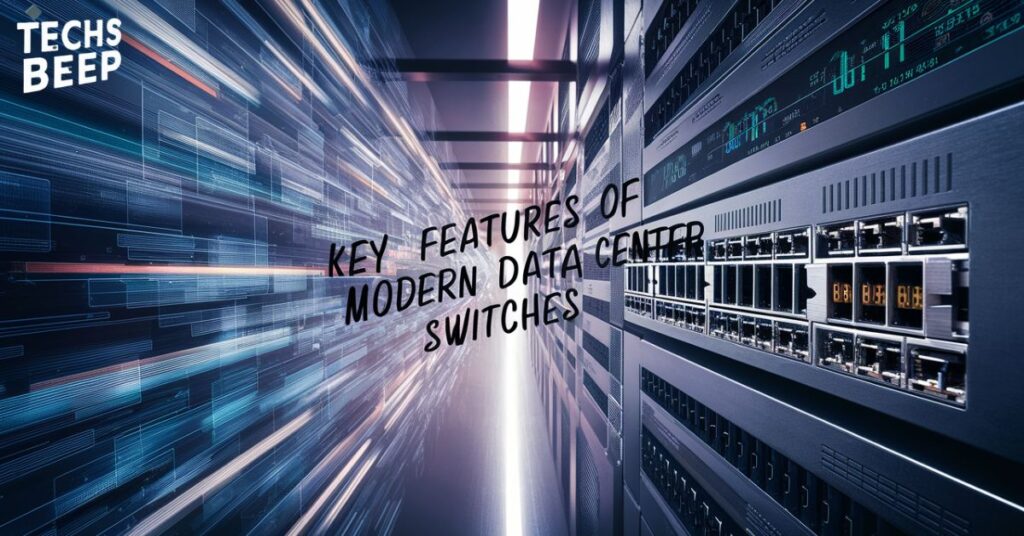Data center switches are the backbone of modern network infrastructure. They enable fast, reliable communication between servers, storage systems, and other devices, unlocking the full potential of your data center’s computing power.
Is your data center keeping up with today’s demanding workloads and applications? Discover how cutting-edge switch technologies can supercharge your network performance, reliability, and scalability for the future.
Data center switches are evolving rapidly to meet the growing needs of modern businesses. These advancements offer improved speed, efficiency, and management capabilities, transforming how data centers operate and perform.
Understanding Data Center Switches
Data center switches are specialized networking devices that connect servers, storage systems, and other equipment within a data center. They handle high-speed data transfer, ensuring smooth communication between various components of the network infrastructure.
Modern data center switches offer advanced features like high port density, low latency, and support for multiple protocols. These capabilities allow for efficient data routing, improved network performance, and better scalability to meet growing data center demands.
What is a Data Center Switch?
A data center switch is a specialized networking device designed to connect servers, storage systems, and other equipment within a data center. It acts as a central hub, directing data traffic between different devices and ensuring fast, efficient communication.
These switches come in various sizes and capabilities, ranging from small top-of-rack switches to large core switches. They play a crucial role in maintaining network performance, reliability, and security in modern data centers.
Importance of Data Center Switches
Data center switches connect servers and storage systems in data centers, enabling high-speed data transfer. They ensure smooth communication between network components.
Modern switches offer high port density, low latency, and multi-protocol support. These features improve network performance and scalability for growing data center needs.
Key Features of Modern Data Center Switches

Modern data center switches boast high-speed connectivity, often reaching 100Gbps or more. They offer advanced features like software-defined networking (SDN) support, enhanced security protocols, and improved power efficiency.
High Port Density
Modern data center switches offer unprecedented port density. This means more connections in less space, allowing for efficient use of limited data center real estate and easier scalability.
Low Latency
Low latency is crucial for time-sensitive applications in data centers. Modern switches minimize delays, ensuring data travels quickly between devices for optimal performance.
Scalability and Flexibility
Modern data center switches offer unparalleled scalability to accommodate growing network demands. They provide flexible configurations that can adapt to changing business needs without requiring a complete infrastructure overhaul.
Security Features
Modern data center switches come with advanced security features to protect your network. These include robust encryption, access control lists, and real-time threat detection to safeguard your valuable data and infrastructure.
Read this Blog: Minecraft Game Icons and Banners: Exploring Their Design and Impact
Choosing the Right Data Center Switch

Selecting the right data center switch is crucial for optimal network performance. Consider factors like port density, speed requirements, and scalability to match your current and future needs.
Compatibility with existing infrastructure and support for emerging technologies are also important considerations. Don’t forget to evaluate the switch’s management features and energy efficiency to ensure long-term value.
Factors to Consider
When choosing data center switches, several key factors must be considered.
These crucial elements are outlined below:
- Port speeds and types: Ensure compatibility with your network devices.
- Latency requirements: Minimize delays for faster data transmission.
- Throughput needs: Handle large volumes of data efficiently.
- Automation and management capabilities: Simplify network operations and reduce manual tasks.
- Security protocols: Protect sensitive information with advanced security features.
Comparing Modular vs. Fixed Configuration Switches
Learn the differences between modular and fixed configuration switches to choose the best fit for your data center needs.
Modular Switches
Modular switches offer flexibility and scalability for growing networks. They allow you to add or change modules as needed, adapting to your data center’s evolving requirements and ensuring long-term efficiency and performance.
Fixed Configuration Switches
Fixed configuration switches come pre-built with a set number of ports and features, making them straightforward and hassle-free to deploy. They are cost-effective, reliable, and ideal for smaller networks with straightforward requirements, offering quick setup and easy management.
High Performance vs. High Density: What’s the Difference?
Understand the difference between switches focused on speed and those designed for connecting many devices efficiently.
High Performance
High-performance switches prioritize speed and responsiveness, ideal for applications demanding rapid data processing and low latency.
- Designed for intensive workloads like financial trading.
- Equipped with powerful processors for swift data handling.
- Support advanced Quality of Service (QoS) for prioritizing critical applications.
- Ensure minimal network congestion during peak usage.
- Optimize performance with sophisticated routing and traffic management capabilities.
High Density
High density switches prioritize packing more ports into a smaller physical space, making them ideal for environments needing to connect numerous devices efficiently.
- Maximizes Port Count: Offers a high number of ports per switch unit.
- Space Efficiency: Reduces the physical footprint required for networking equipment.
- Cost-effective: Lowers per-port costs compared to lower-density options.
- Simplified Cabling: Streamlines network infrastructure with fewer cables.;
- Scalability: Easily expands to accommodate growing network demands.
Leading Data Center Switch Providers
| Provider | Key Features | Unique Selling Points |
| Cisco System | High performance, robust security | Extensive scalability with Nexus series |
| Arista Networks | Programmable switches, automation support | Advanced telemetry capabilities |
| Juniper Networks | High density, low-latency solutions | Tailored for modern data centers |
| HPE/Aruba | Integration with comprehensive management | Enhanced ecosystem support |
| Dell EMC | Competitive product range | Focus on integrated solutions |
Benefits of Using Advanced Data Center Switches

Discover the advantages of upgrading to advanced data center switches for improved network efficiency and security.
Enhanced Network Performance
Enhanced network performance ensures your data center operates at optimal speeds, minimizing delays and improving overall efficiency.
- High-speed data transfer capabilities.
- Low latency for quicker response times.
- Efficient handling of large data volumes.
- Enhanced reliability during peak usage.
- Seamless integration with modern applications and services.
Improved Scalability
Enhanced scalability in data center switches allows for seamless expansion and adaptation to growing network needs.
- Easily add more devices and users without compromising performance.
- Scale bandwidth and capacity dynamically as demand increases.
- Support for virtualization and cloud integration facilitates flexible resource allocation.
- Modular designs enable customization and future-proofing.
- Simplify network management with centralized controls for multiple locations.
Simplified Management
Achieve streamlined operations with simplified management capabilities offered by advanced data center switches.
- Centralized control and configuration reduce manual errors.’
- Automated tasks like network provisioning enhance efficiency.
- Intuitive interfaces and dashboards simplify monitoring and troubleshooting.
- Support for software-defined networking (SDN) enables dynamic network adjustments.
- Real-time analytics provide insights for proactive management.
Increased Security
Enhanced security in advanced data center switches ensures protection against cyber threats and data breaches.
- Robust encryption methods safeguard sensitive data.
- Access control mechanisms limit unauthorized access.
- Advanced threat detection and prevention capabilities.
- Regular security updates and patches maintain system integrity.
- Compliance with industry standards ensures regulatory requirements are met.
Read this Blog: Investigating the Potential of the Plugboxlinux Gaming Platform
Final Words
In conclusion, upgrading to the latest data center switch technologies enhances network performance and efficiency. These solutions streamline data flow, minimize latency, and support scalable operations, ensuring smooth performance even during peak usage.
Moreover, the robust security features integrated into these switches provide comprehensive protection against cyber threats and unauthorized access, meeting compliance standards and fortifying network resilience.
By embracing these advancements, businesses not only stay competitive but also future-proof their infrastructure. With improved performance, scalability, and security, organizations are poised to excel in the dynamic digital landscape,, ensuring sustained growth and operational success.
Frequently Asked Questions
What are the main differences between data center switches and traditional network switches?
Data center switches are designed for high-bandwidth and low-latency requirements, often supporting features like automated configuration and advanced virtualization.
How does low latency impact data center performance?
Low latency is critical for applications that require real-time data processing, ensuring quick response times and efficient operations.
What should I consider when choosing a data center switch provider?
Look for providers offering high performance, robust security, scalability, and support for advanced features like automation and telemetry.
How can advanced data center switches enhance security?
They support robust security protocols, including encryption and access controls, to protect sensitive information and prevent data breaches.
What are the advantages of modular switches over fixed configuration switches?
Modular switches offer greater flexibility and scalability, allowing for easy expansion and customization to meet specific network needs.








